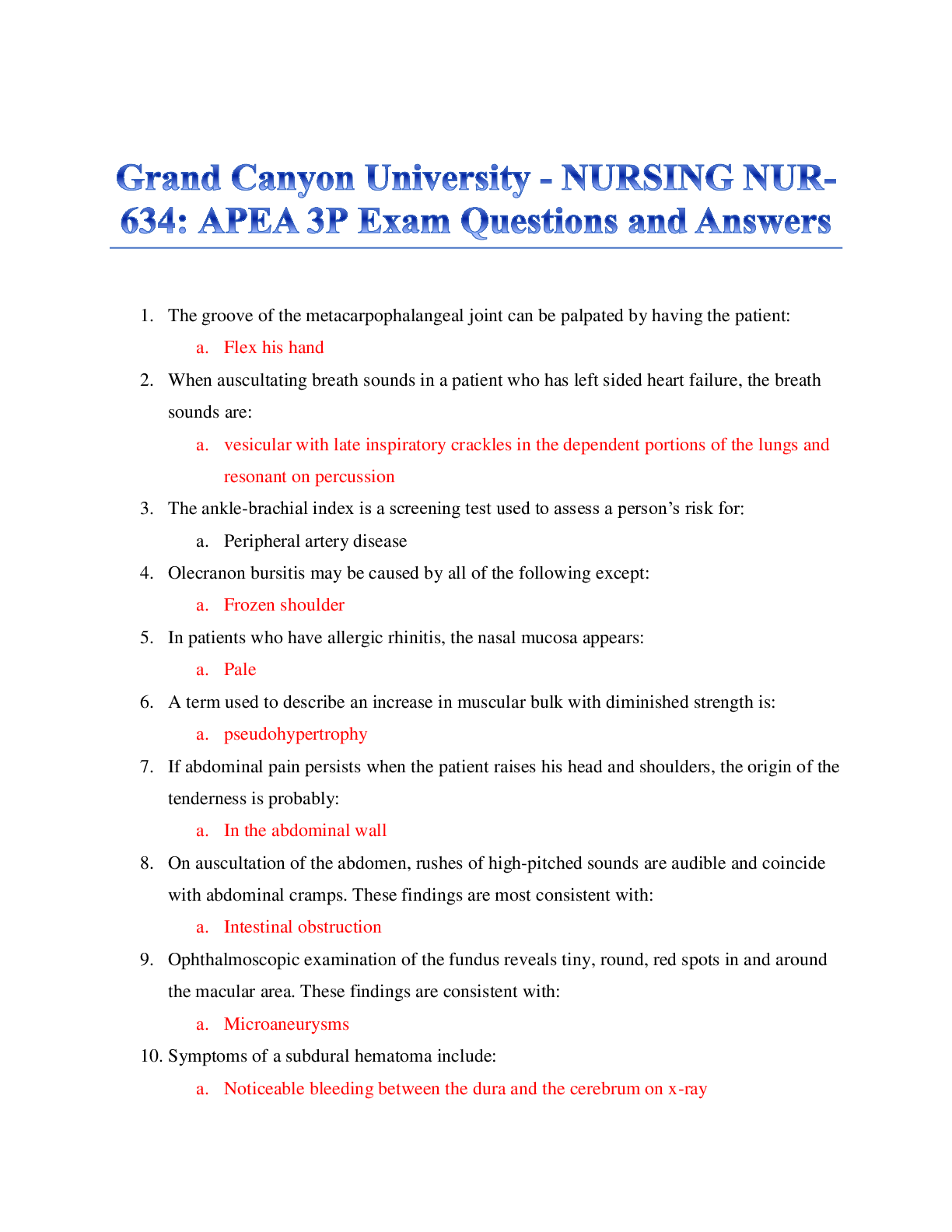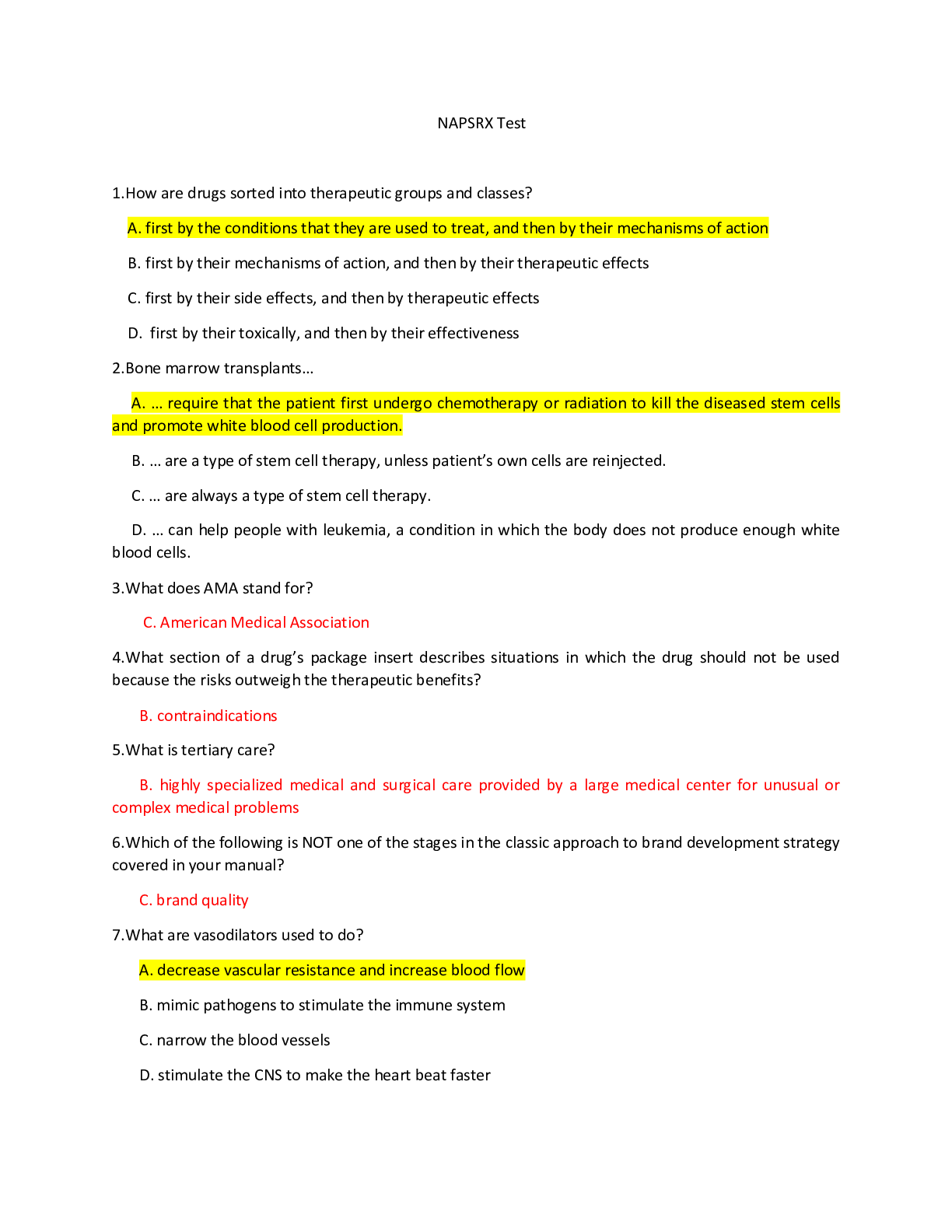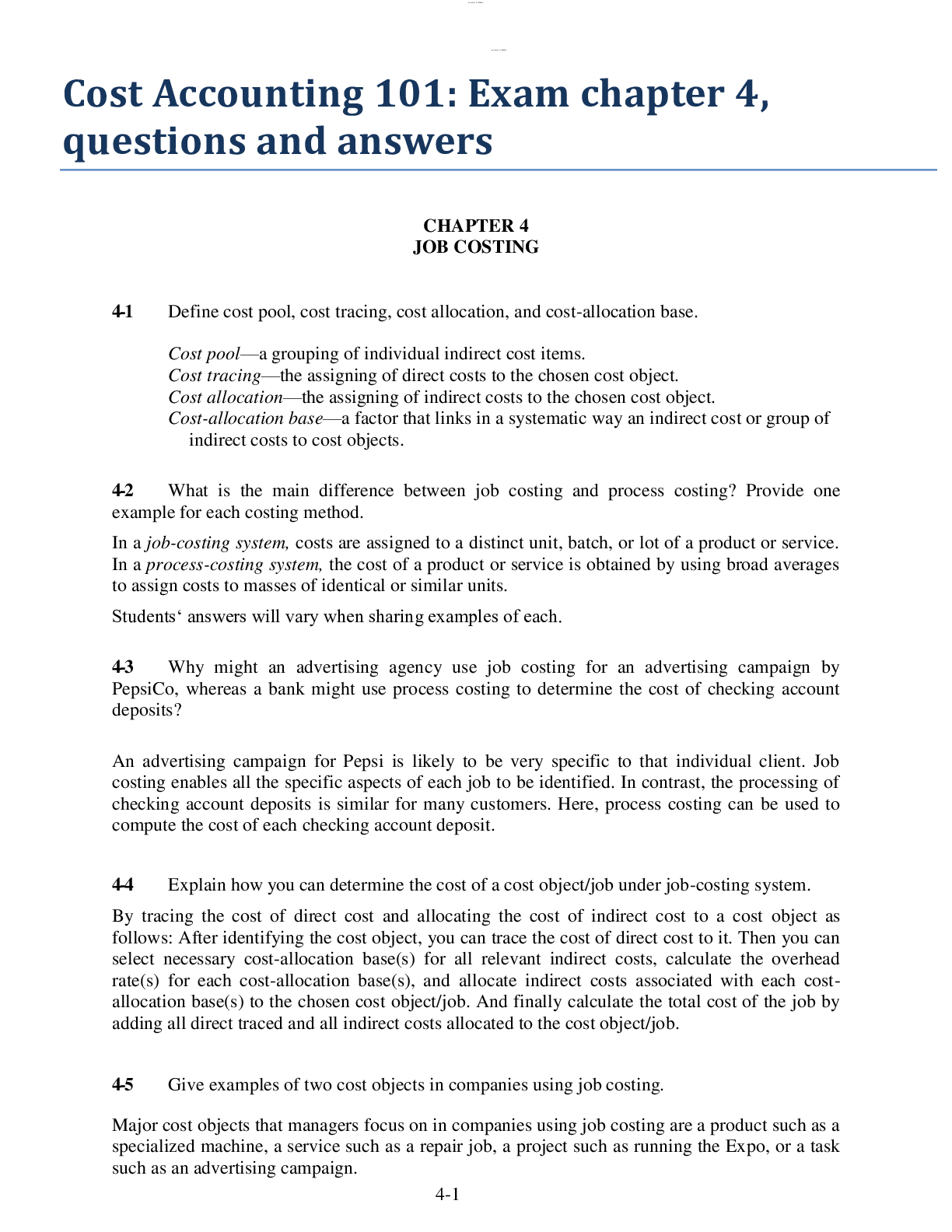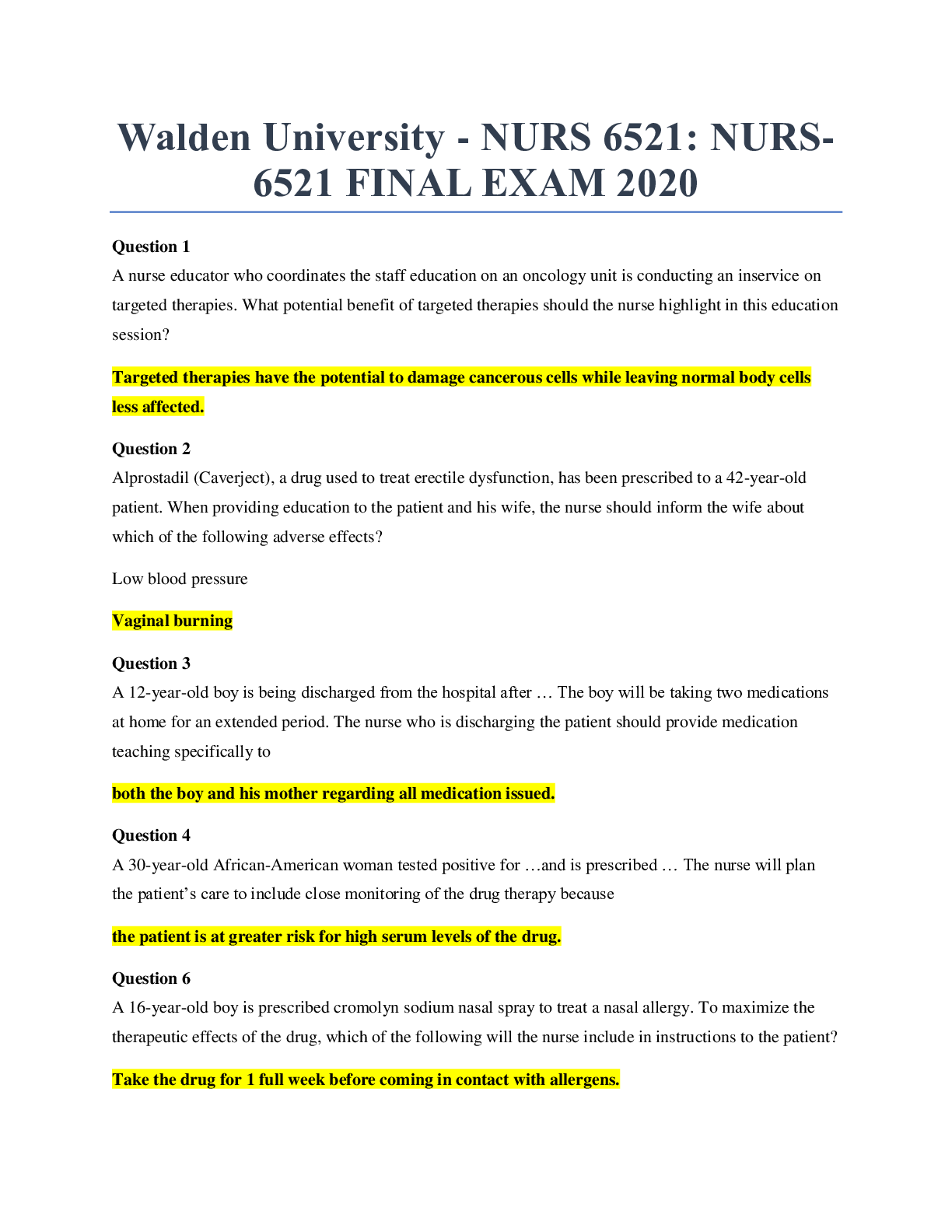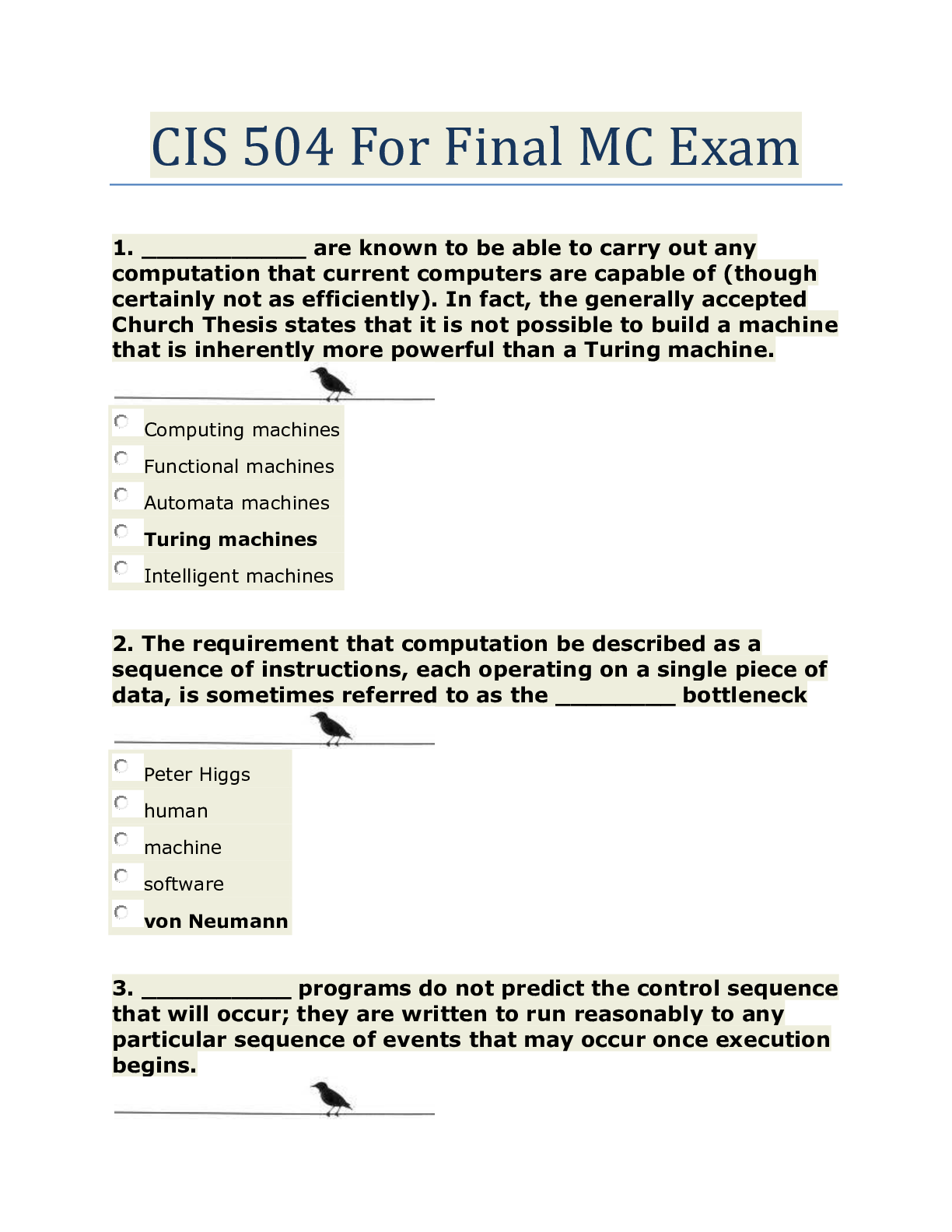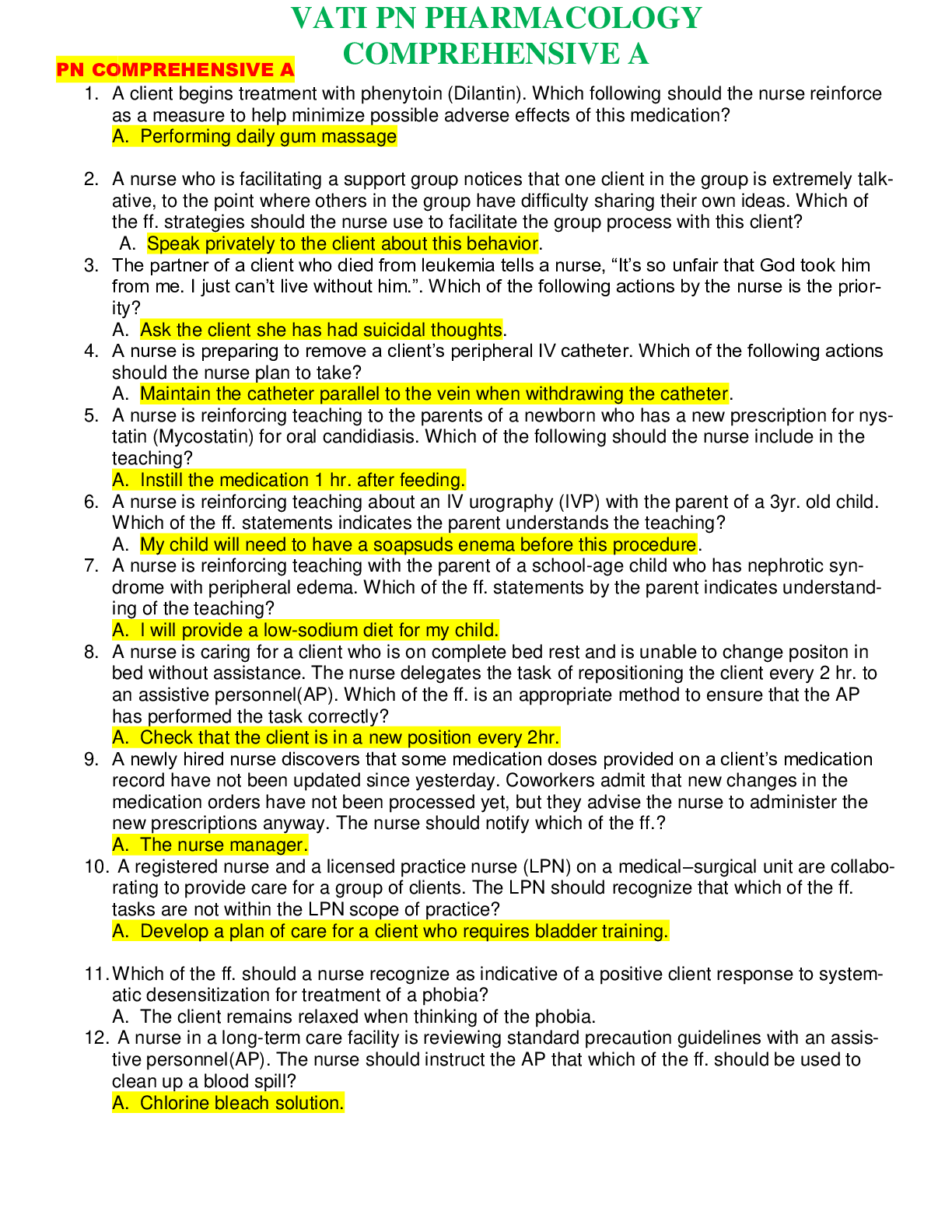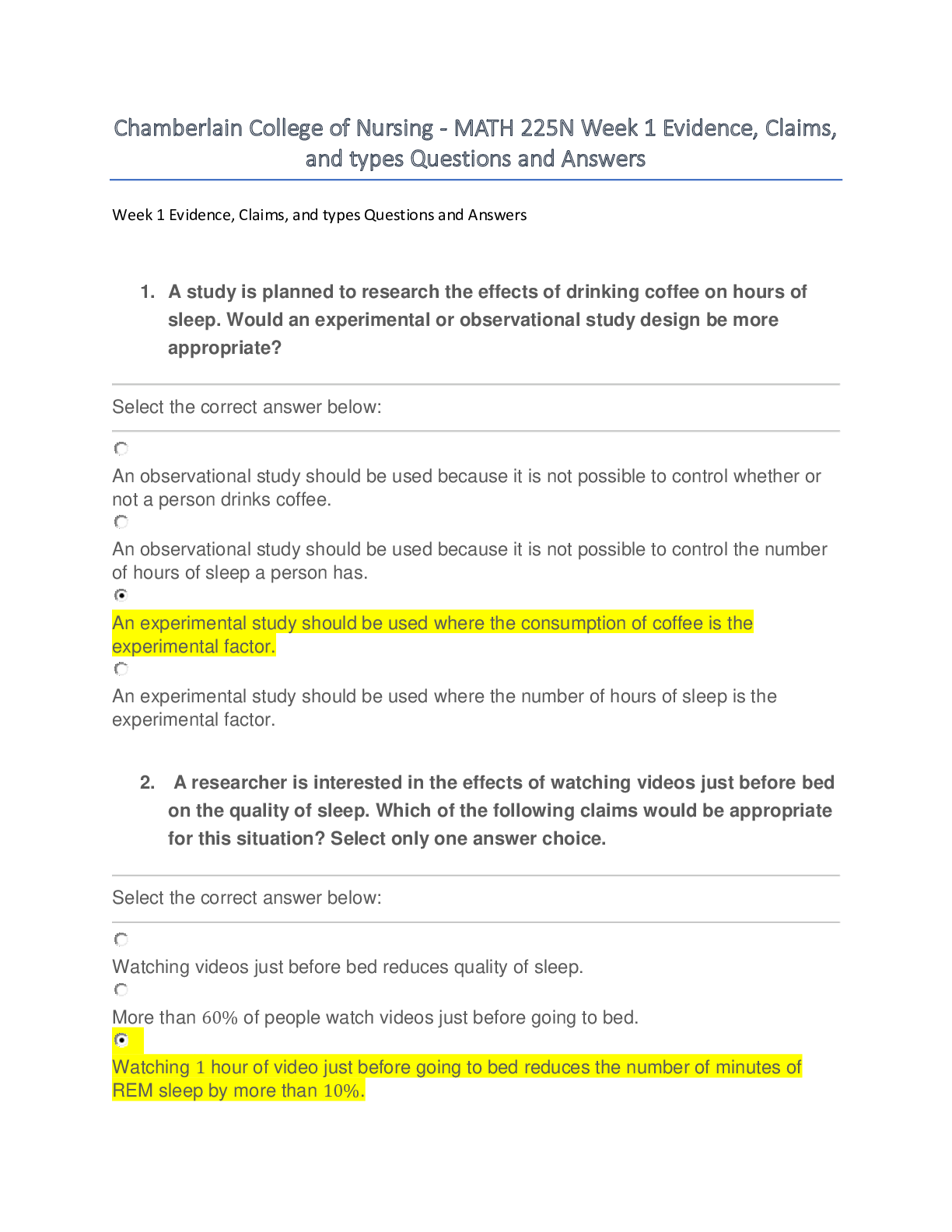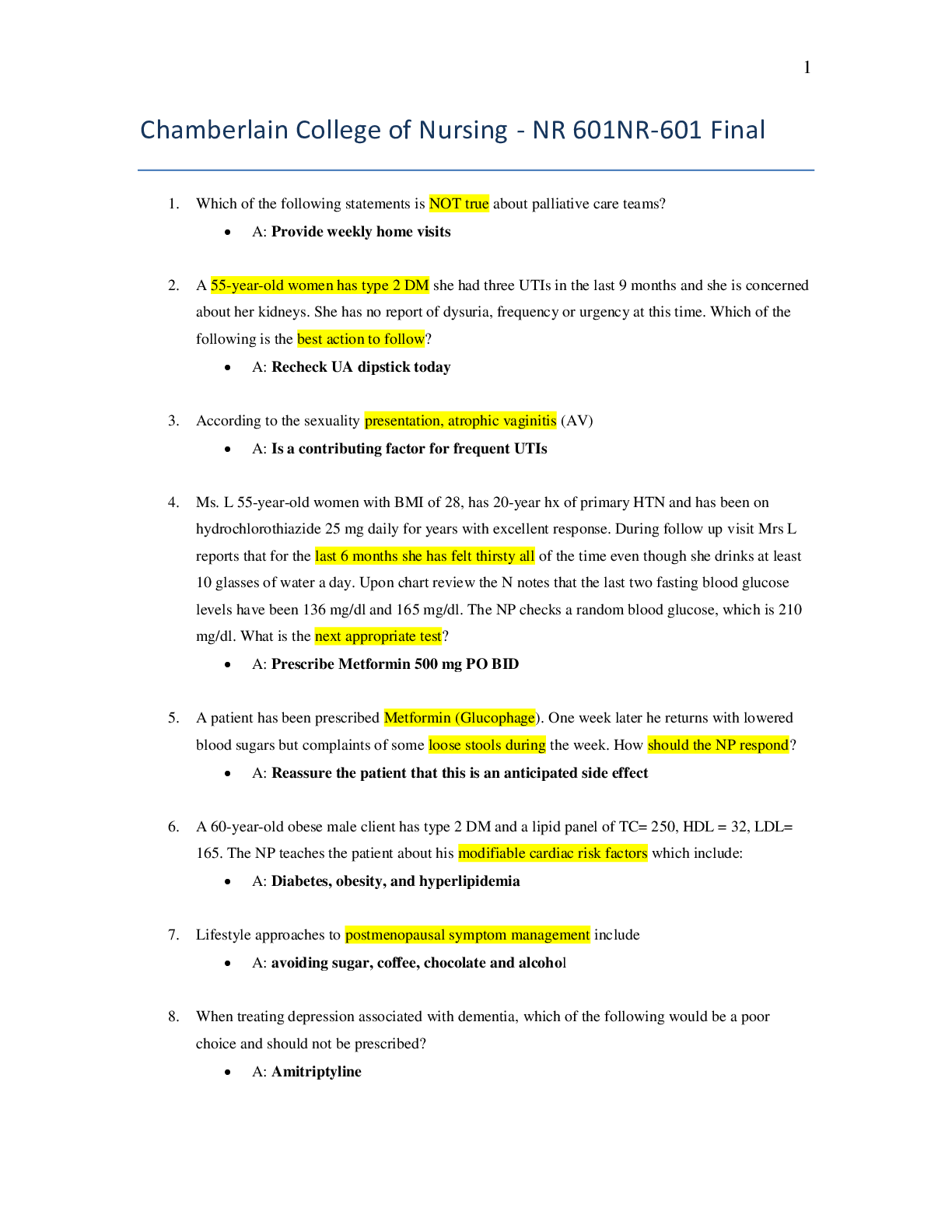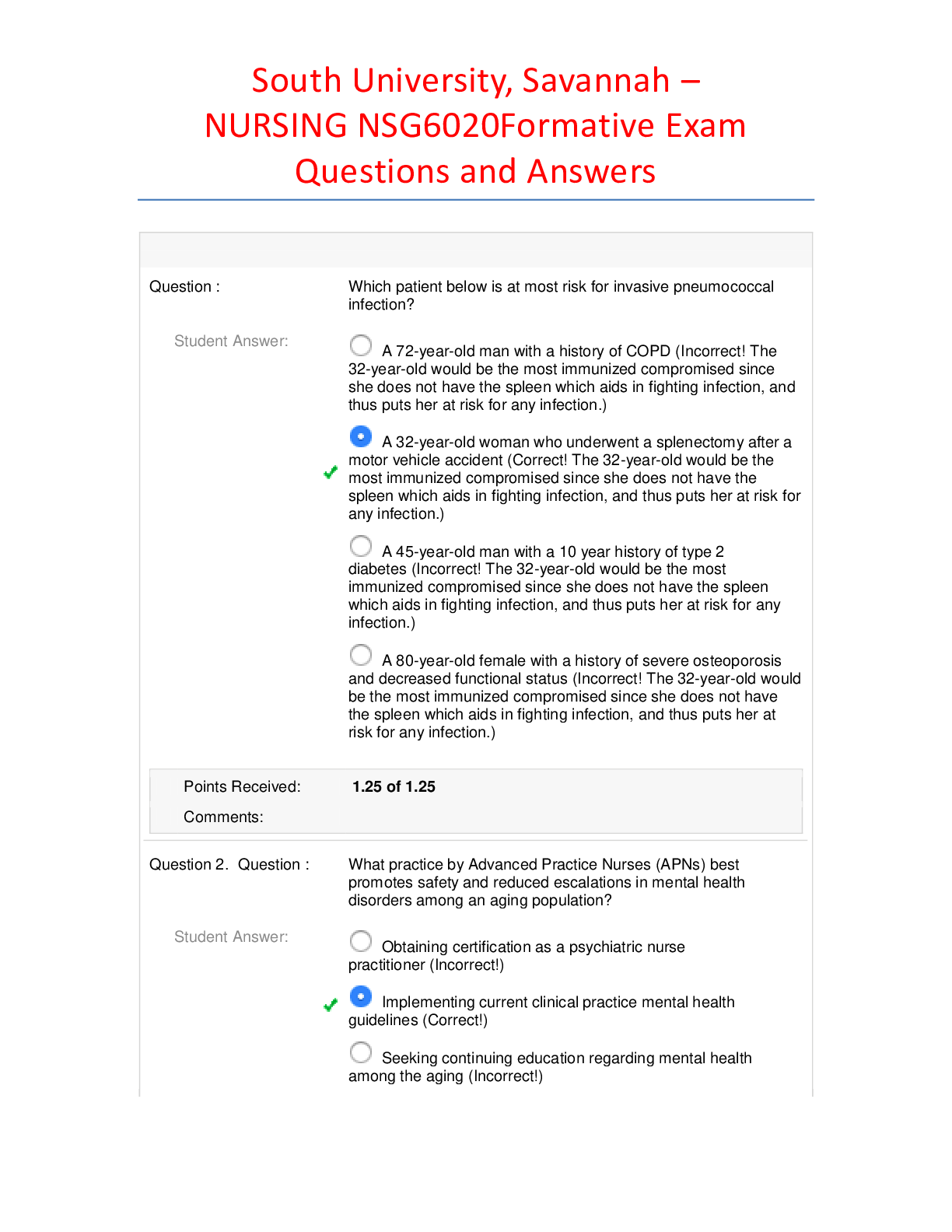Chapter 2 Promoting Children's Art Questions and Answers. Graded A. 100%
Document Content and Description Below
Creative Thinking & Arts-Based Learning 7e (Isenberg/Jalongo) Chapter 2 Supporting Children's Play, Games, and Inventions 1) Which type of play is characterized by using imagination to transform... self and objects? A) symbolic play B) constructive play C) games with rules D) functional play 2) Classical theories of play include all of the following except: A) practice B) recreation/relaxation C) surplus energy D) recapitulation E) psychoanalytic theory 3) A group of young children are called to the meeting area by their teacher and she leads them in a finger play. Which type of play does this represent? A) work disguised as play B) child-initiated play, freely chosen C) directed play D) facilitative play 4) Play offers an opportunity to respect cultural diversity. The teacher needs to: A) formally teach cultural differences before play begins B) provide varied materials and books representing different cultures for children to explore C) refrain from learning too much about a culture to avoid influencing the play D) formally introduce children from other cultures into the classroom 5) Sociodramatic play: A) is pursued in isolation B) relies exclusively on nonverbal communication C) is purely imitative D) involves more than one child in verbal communication and interaction around a jointly-elaborated sequence or theme. 6) Play serves a vital role in children's social development because it: A) Increases social competence B) Allows them to practice communication skills C) Allows them to take on other roles and points of view D) Teaches them to share E) All of the above 7) According to the text, play supports children's emotional development by all of the following except: A) Providing an outlet to express feelings B) Teaching them to explore other roles C) Providing a way to deal with powerful emotions D) Sharing materials and experiences E) Teaching them to control and suppress emotions 8) During the infant through toddler stage, children engage in: A) Symbolic play B) Sociodramatic play C) Functional play D) Constructive play 9) Teachers should intervene in children's play in all of the following situations except: A) An argument or fight arises B) A child is unable to accomplish an objective C) When a task selected by the children appears to be too difficult or dangerous D) A child asks for their participation E) When children appear to be watching others play 10) When teachers provide feedback on a child's play activity, they are acting as a(n): A) Responder B) Mediator C) Collaborator D) Observer E) Monitor 11) Activities such as singing ABC songs, spelling games, and addition facts races are considered ________ learning. A) discovery B) guided C) reception D) rote E) repetitive 12) Group games, fingerplays, and directed story reenactment is considered ________ learning. A) discovery B) guided discovery C) receptive D) rote E) repetitive 13) Which characteristic is not associated with play? A) the child is in control B) the child engages freely in pretend C) stringent time constraints are placed on the activity D) the activity is child-directed 14) This theorist emphasized the way children use play as a vehicle for social interaction and the development of the social tool called language. A) Piaget B) Erikson C) Freud D) Vygotsky E) Gesell 15) A first-grade teacher suggests to his team that recess should be replaced with additional instructional time for letter recognition remediation activities. What does research show about this suggestion? A) Children do not need recess; they can play at home. B) Learning letters is much more important than any physical skill. C) Children need the physical activity offered during recess. D) Fine motor skills are far more important than large motor skills in young children's development. 16) In order to model storytelling to her group of second graders, a teacher can: A) Show a video of a celebrity reading the story B) Play a video recording of the book's text C) Tell the story using simple props D) Read the story to the children using different voices for each character 17) Arturo, a third grader and ELL, appears to be disinterested in many of the picture books that his teacher shares during class. How could his teacher offer support? A) Send the books home and ask his parents to explain the stories to him. B) Don't worry about the problem unless his grades fall. C) Give him a copy of the story to read at home. D) Build prior knowledge before sharing books, identify bilingual books (with the text written both in English and in Spanish), incorporate stories from his Hispanic heritage, and allow him to choose books that match his particular interests. 18) When reading a nonfiction book that relates to the fairy tale read in the basal reader, the teacher is disappointed because her first-graders are not asking questions or showing excitement about the material. What is an effective strategy the teacher can use to encourage more student engagement? A) Wait until the next day; maybe the children will be ready to discuss it later. B) Pause periodically and ask the children to explain or "recap" what has happened thus far in the story and to ask questions about anything that is unclear. C) Tell the children to listen carefully an+9d reread the story aloud very slowly to facilitate understanding. D) Stop reading the story until students are more engaged in the text. 19) A teacher is watching her preschoolers pretend to be cooks who are preparing food for other children pretending to be servers and customers. She thinks this could be a good math learning experience, so she stops the play and sets up a toy cash register. Her purpose is to teach the children the numbers on the various play money coins and bills. Based on what you have read in your text thus far, which of the following perspectives is most accurate? A) This is a highly effective way to add a math objective into play. B) The teacher has intervened to the extent that this activity is no longer play; it is a teacher-directed lesson. C) The teacher should omit pretend play in the daily schedule altogether and replace it with math worksheets. D) Teachers should always be an observer and remain on the sidelines when children are engaged in spontaneous play. 20) A group of third graders have been begging to play the new board games that were purchased by the parent/teacher group for their classroom, but the teacher is unsure about how to proceed because he doesn't think that a couple of the students would handle games well. What should the teacher do? A) Avoid using the games until the children in question are absent or working with an aide. B) Organize the games from simple to complex, introduce them one at a time, demonstrate the object and rules of each game, provide children with guided practice, and assign children to small groups—based on their strengths and interests. C) Reserve the games as a reward for the top students who have completed all of their work. D) Store the board games on a high shelf and use them during indoor recess only. 21) Mia and Emmy are at the water table. Mia is pretending her boat is under attack by pirates. Emmy is pretending to be in the kitchen washing dishes. Although both girls are playing at the same location they are using the water in very different ways. What kind of play is this an example of? A) cooperative B) associative C) solitary D) parallel 22) A four-year-old boy is playing by himself. He is pretending to be a doll's father and asks the doll if he wants to go outside and play ball after lunch. Which classical theory of play best explains this behavior? A) surplus-energy B) recreation/relaxation C) practice D) recapitulation 23) Since the early 1990s researchers focused on ________ has impacted beliefs and practices in early childhood learning. A) neuroscience B) inquiry learning C) the whole child as a learner D) all of the above 24) The creative arts include: A) art B) music C) movement D) dance E) drama F) storytelling G) all of the above 25) Research on play shows that play helps children develop: A) sophisticated classification skills B) higher order thinking skills C) the ability to use prior knowledge when constructing new understandings D) all of the above 26) Some adaptations that teachers can make to include diverse learners in play include: A) Providing many opportunities for dramatic play to offer group interactions and build comfort among the peer group B) Provide children with a script to help children understand the language of play C) Create a separate activity for the children with developmental or language delays D) Explain what is happening in the play setting E) All of the above except for C 27) Use the following choices to answer the items below. A. functional play B. symbolic play C. constructive play D. games with rules 1. ___A____ Referred to as sensorimotor, practice, or exercise play. 2. ___C____ When the child focuses on a lasting end product. 3. ___D____ Fourth graders playing Monopoly or Scrabble. 4. ___C____ Used most frequently by preschoolers to create something according to a preconceived plan. 5. ___B____ A group of kindergartners are playing veterinarian's office with stuffed toys as patients. 6. ___A____ Infants grasping a mobile. 7. ___B____ A toddler pretends to drink from her empty cup. 8. ___D____ A type of play that depends on skills such as coordination, language, cooperation, and competition. 9. ___D____ School-aged children playing marbles. 10. ___A____ Typical play of an infant who fills and empties a plastic milk bottle. 28) Match each modern theorist with the correct description. A. Vygotsky B. Freud C. Erickson D. Bruner E. Piaget 1. ____C___ Play develops self-esteem as children gain mastery of physical and social skills. 2. ____E___ Children individually create their own knowledge about the world through different types of play. 3. ____B___ Play is an important vehicle for emotional release. 4. ____A___ Play acts as a mental support that enables children to solve problems in new ways (Zone of Proximal Development). 5. ____D___ Play promotes flexible thinking and creative problem solving. 29) Match each play characteristic to the example it best describes below. A. intrinsically motivated B. symbolic C. active D. rule-bound E. pleasurable F. A and C 1. When children who are engaged in hospital play decide to use a toy stethoscope, use real gauze for bandages, and write out prescriptions on a note pad, this illustrates the ____F_____ characteristic of play. 2. If a group of kindergartners are at play and one says, "No! Robbers aren't supposed to get away from the cops," this illustrates the ____D____ characteristic of play. 3. When children return to a favorite play theme over and over again, this is evidence that the play is ___E_____. 4. If a teacher assigns a play theme to children, it is no longer ___A_____. 5. If a child uses one thing to stand for something else, such as a puzzle for a food tray, this illustrates the ____B____ characteristic of play. 30) Match the level of social play to its description or example. A. unoccupied behavior B. onlooker behavior C. solitary play D. parallel play E. associative play F. cooperative play G. A, B, and C 1. ____E___ Children play with each other in similar loosely organized activities; some attempts made to control who may join the group. 2. ___B____ A child stands within speaking/hearing distance and observes, asks questions and talks to other children but does not actually enter into play. 3. ___A____ A child simply watches the activity of others; tends to wander about aimlessly and glance around the room. 4. ____D___ A child plays alongside or nearby another child; uses like toys but does not really share. 5. ____F___ Children engage in complex, social organization with shared common goals such as making a product, dramatizing a situation, or playing a formal game; children take different roles and have a strong sense of belonging or not belonging to the group. 6. ____F___ A group of second graders playing kick ball or Red Rover. 7. ___B____ A level of play common in children who are newcomers to the group or culture. 8. ___C____ A level of play typical among infants or toddlers. 9. ___F____ A level of play common among school-age children. 10. ___G____ Type of play in which little direct involvement in another child's play takes place. 11. ___F____ The most socialized form of play. 12. ___D____ If two toddlers play side by side with blocks, this is play. 31) Match the role of the teacher in play to the description or example. A. observer B. collaborator C. planner D. responder E. model F. mediator 1. ___F____ When John and Maria argue over a block, Mr. Tony steps in and helps the children negotiate to solve the problem. 2. ___D____ Ms. Sonya comments on the Raya’s Lego car, “I see you have built a fast car with your Legos.” 3. ___E____ In the home living area Mr. Garcia asks Reagan, “Please pass the milk.” 4. ___A____ Ms. Wanda notices that Grace is struggling with a complicated puzzle and is getting frustrated. 5. ____B___ Mr. Gary joined the children in the block area when invited to play in a game by the children. 6. ___C____ Ms. Gemma places a magnifying glass and several small rocks and gems on a table for the children to explore during morning exploration. 32) Games and inventions teach little to help children attain valuable emotional skills. Answer: FALSE 33) Play has little or no effect on developing social competencies in children. Answer: FALSE 34) Dramatic play that involves more than one child and has verbal communication about the play is called sociodramatic play. Answer: TRUE 35) The teacher has responsibilities for play that encompass allocating time, providing play materials, and functioning as a facilitator for children's play. Answer: TRUE 36) Preschool children usually prefer competitive games. Answer: FALSE 37) Children with special needs cannot be expected to participate in play activities. Answer: FALSE 38) The recreation/relaxation theory of play suggests that play replenishes energy used during work. Answer: TRUE ****39) Playing with writing tools helps children to develop large motor control skills. Answer: FALSE 40) Singing ABC songs is an example of work disguised as play. Answer: TRUE 41) Play has a developmental sequence. Answer: TRUE 42) Play contributes to all areas of children's development. Answer: TRUE 43) Since play is purely a recreational activity for children, it has no significant impact on their cognitive development. Answer: FALSE 44) Much of the research on play shows its relationship to the development of children's ability to relate to other cultures. Answer: FALSE 45) Active play contributes to children's gross motor development. Answer: TRUE 46) Games provide opportunities to learn and practice skills across all learning domains. Answer: TRUE 47) As children mature and enter the primary grades, their play tends to focus more on games with rules. Answer: TRUE 48) For older children, the ability to use a reflective and analytical approach to language is unrelated to their level of linguistic awareness and achievements. Answer: FALSE 49) Teachers should assume a role that dominates the direction of children's play. Answer: FALSE 50) Standards are statements that guide what children should know and be able to do in a given content area at a given time. Answer: TRUE [Show More]
Last updated: 2 years ago
Preview 1 out of 10 pages
Buy this document to get the full access instantly
Instant Download Access after purchase
Buy NowInstant download
We Accept:

Reviews( 0 )
$15.00
Can't find what you want? Try our AI powered Search
Document information
Connected school, study & course
About the document
Uploaded On
Feb 22, 2021
Number of pages
10
Written in
Additional information
This document has been written for:
Uploaded
Feb 22, 2021
Downloads
0
Views
128

.png)






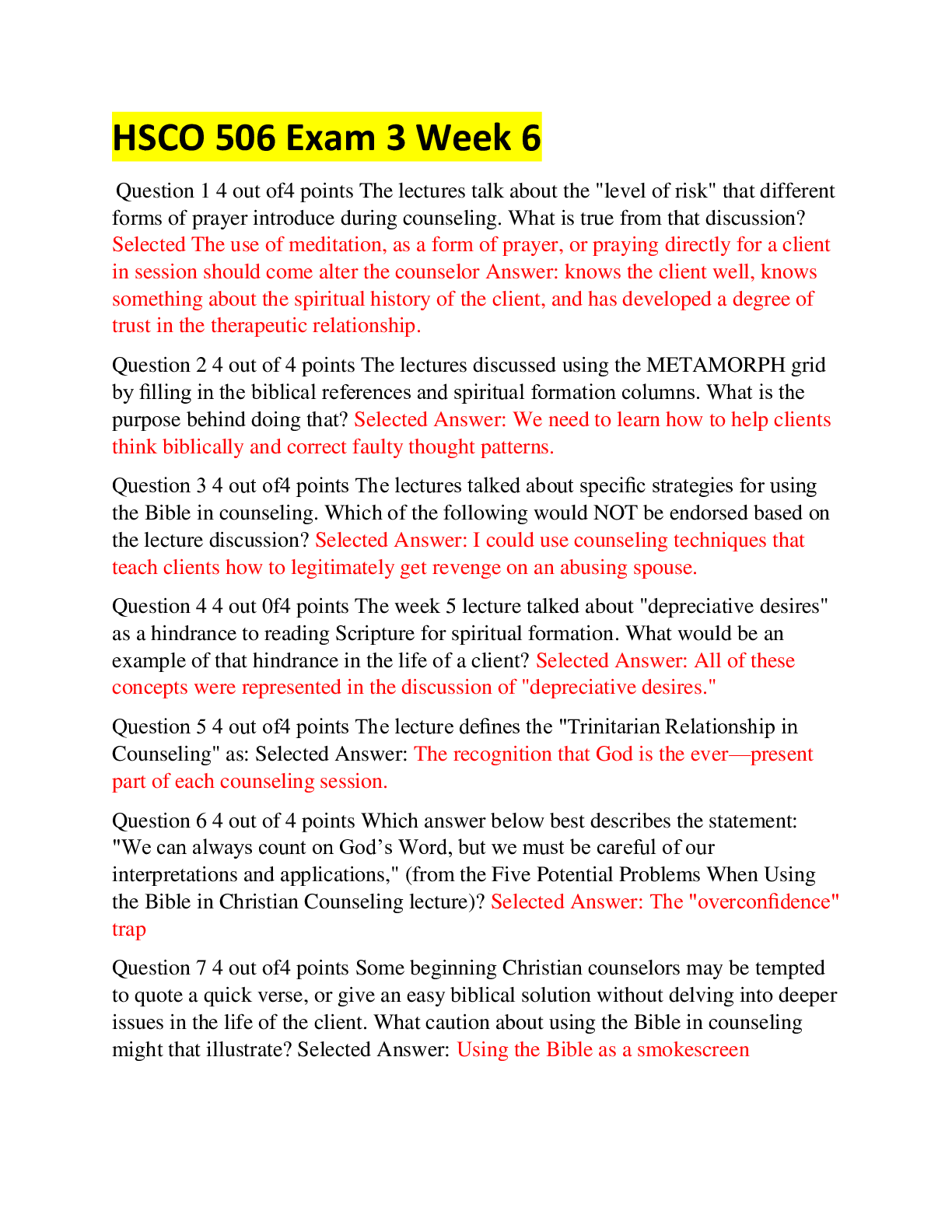

.png)




